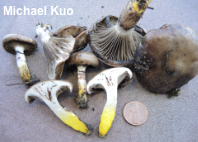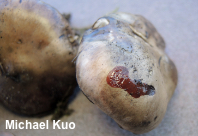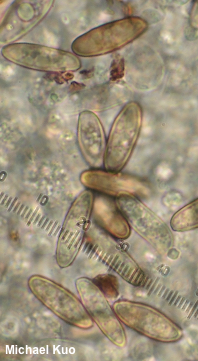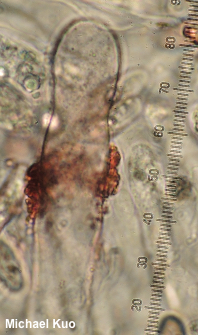| Major Groups > Gilled Mushrooms > Dark-Spored > Gomphidius > Gomphidius glutinosus |

|
Gomphidius glutinosus [ Basidiomycota > Boletales > Gomphidiaceae > Gomphidius . . . ] by Michael Kuo Gomphidius glutinosus is currently defined as a species found on four continents, associated with many different conifers, but it may well turn out to be a species complex once DNA studies take a closer look. For the time being, however, it can be recognized by its fairly large, slimy cap, and its slimy stem with a chrome yellow base. Some versions of Gomphidius glutinosus are grayish brown to brownish gray, like the collection featured here. Other versions are pinkish brown or pinkish gray, or even purple-brown. Gomphidius oregonensis is similar, but it tends to grow in clusters (Gomphidius glutinosus does not) and has substantially shorter spores. Gomphidius subroseus is also similar, but features a pink to red cap. Description: Ecology: Mycorrhizal with conifers—especially, but not exclusively, with spruces and firs; growing alone or scattered; summer and fall, or over winter in warm climates; northern and montane North America; also distributed in Europe, Asia, and northern Africa. The illustrated and described collection is from Colorado. Cap: 3–8 cm wide; convex, becoming broadly convex; bald; often with a radially streaked appearance; slimy; grayish brown to brownish gray or lilac brown; discoloring black with age; the margin sometimes with a blackish line. Gills: Running down the stem; close or nearly distant; whitish at first, becoming dark gray; short-gills frequent. Stem: 4–8 cm long; 1–2 cm wide; tapering to base; with a slime veil above a fibrillose veil, sheathing all but the upper portion; upper edge of slime veil turning dark gray as spores mature and fall from the gills; whitish above; whitish to brownish below, but chrome yellow near the base or over the lower half; discoloring blackish. Flesh: White in cap and upper stem; bright chrome yellow in lower stem. Odor and Taste: Odor not distinctive; taste slightly acidic. Chemical Reactions: KOH dark red on cap surface. Spore Print: Dark gray to nearly black. Microscopic Features: Spores 15–20 x 5–6.5 µm; subfusiform; smooth; brownish to brown in KOH. Basidia 4-sterigmate. Hymenial cystidia 80–130 x 15–22 µm; widely cylindric to subutriform; smooth; thin-walled; hyaline in KOH. Pileipellis an ixocutis. Clamp connections not found. REFERENCES: (Schaeffer, 1774) Fries, 1838. (Kauffman, 1925; Singer, 1949; Miller, 1971; Smitgh, 1975; Smith, Smith & Weber, 1979; Thiers, 1985; States, 1990; Breitenbach & Kränzlin, 1991; Lincoff, 1992; Barron, 1999; Miller, 2002; Miller, 2003; McNeil, 2006; Miller & Miller, 2006; Trudell & Ammirati, 2009; Desjardin, Wood & Stevens, 2015; Evenson, 2015; Siegel & Schwarz, 2016; Sturgeon, 2018; Læssøe & Petersen, 2019.) Herb. DBG RMNP 2008-021, CMS-2018-0101. This website contains no information about the edibility or toxicity of mushrooms. |
© MushroomExpert.Com |
|
Cite this page as: Kuo, M. (2020, February). Gomphidius glutinosus. Retrieved from the MushroomExpert.Com Web site: http://www.mushroomexpert.com/gomphidius_glutinosus.html |



